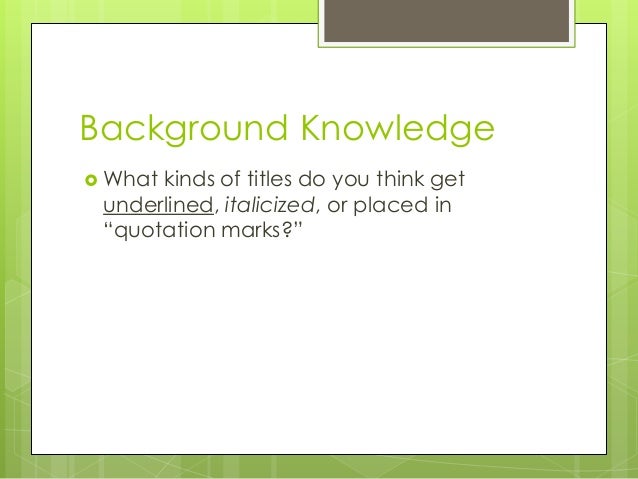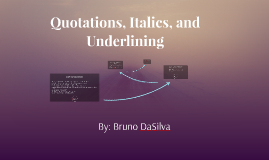Quotes Vs Italics
- As a writer, you know that titles are distinguished from surrounding text with italics and quotation marks. What you may not know, however, is when to use which one. Let’s clear up the mystery. Titles of large, stand-alone works such as books, plays, newspapers, magazines, movies, and epic poems are italicized.
- The common rule is, though, that everything spoken aloud is enclosed in double quotations, while a quotation within a quotation is set apart with single quotes. You're correct in that italics are used for character thought, and aslo for emphasis.
Quotation Marks vs. Italics in Titles When referring to a title, use italics (or underlining in handwriting) for longer works and quotation marks for shorter works. Don't use either one for the title on a document you are writing yourself, such as an essay. You only need to use italics or quotation marks when you are referring to a work.
This page addresses when to use italics, when to avoid italics, how to use italics for emphasis, and when to use reverse italics. Additional cases and examples are provided in the Publication Manual; users’ most common questions are addressed here.
Italics and reverse italics are covered in Sections 6.22 and 6.23 of the APA Publication Manual, Seventh Edition
When to Use Italics
In APA Style papers, use italics for the following cases:
| Case | Example |
|---|---|
First use of key terms or phrases, often accompanied by a definition | Mindfulness is defined as “the act of noticing new things, a process that promotes flexible responding to the demands of the environment” (Pagnini et al., 2016, p. 91). |
Titles of books, reports, webpages, and other stand-alone works | Assessment and treatment of older adults: A guide for mental health professionals |
Titles of periodicals and periodical volume numbers (but not the comma between them) | American Journal of Nursing, 119(9), 47–53. |
English letters used as statistical symbols or algebraic variables | M, SD, t, Cohen’s d |
Anchors of a scale (but not the associated number) | ranged from 1 (poor) to 5 (excellent) a Likert scale (1 = strongly disagree to 5 = strongly agree) |
First use of words, phrases, or abbreviations from another language when readers may not be familiar with them; however, if the term appears in a dictionary for the language in which you are writing, do not italicize it | Their favorite term of endearment was mon petit chou. |
When Not to Use Italics
Do not use italics for the following cases in APA Style papers:
| Case | Example |
|---|---|
Titles of book series | the Harry Potter series |
The punctuation mark after an italicized word or phrase or between elements of a reference list entry (e.g., the comma after a periodical title or issue number, the period after a book title) | Journal of Abnormal Psychology, 128(6), 510–516. |
Words, phrases, and abbreviations of foreign origin that appear in a dictionary for the language in which you are writing | a posteriori |
Italics for Emphasis
In general, avoid using italics for emphasis. Instead, rewrite your sentence to provide emphasis. For example, place important words or phrases at the beginning or end of a sentence instead of in the middle, or break long sentences into several shorter sentences.
However, do use italics if emphasis might otherwise be lost or the material might be misread, as in the following example.
Whereas creative self-efficacy typically focuses on confidence beliefs prior to engaging in creative endeavors, perceived creative credit focuses on the beliefs developed after engaging in creative tasks (Ng & Yam, 2019, p. 1146).
If you add emphasis to a direct quotation, place the words “[emphasis added]” in square brackets after the words you have italicized.
Research on creativity indicates that “promoting creativity without attending to the subsequent psychological and behavioral changes decreases rather than increases [emphasis added] organizational performance over the long run” (Ng & Yam, 2019, p. 1157).
Reverse Italics
When words that would normally be italicized appear within text that is already italicized, those words should be set in standard (nonitalic) type, referred to as reverse italicization. For example, if an italic symbol appears in a table title (which is also italicized), use standard type for the symbol.
Demographic Characteristics of Study Participants(N= 250)
 Remember the days when your manual typewriter didn’t have a key for the number 1, so you used a lowercase letter L instead? And to type an exclamation point, you typed an apostrophe first, backspaced, and then typed a period beneath it? Sure you do, punk.
Remember the days when your manual typewriter didn’t have a key for the number 1, so you used a lowercase letter L instead? And to type an exclamation point, you typed an apostrophe first, backspaced, and then typed a period beneath it? Sure you do, punk.Clarification: I’m not that old; my high school was poor. We pasted our newspaper dummies together with wax and made type changes with a dull razor.
Well, we don’t type that way anymore, because technology has blessed us with 1s and !s on our keyboards. Likewise, because we are capable of rendering type in italics, you underline titles only when writing them by hand or using software that doesn’t italicize. As long as you remember that underlining equals italics and to never underline when you can italicize, you’re good.
You can get pretty far by following the “Big/heavy equals italics” (like books) and “Small/light equals quotes” (like poems) generalizations.
As for enclosing titles in quotation marks or italicizing them, you can get pretty far by following the “Big/heavy equals italics” (like books) and “Small/light equals quotes” (like poems) generalizations, but Associated Press style doesn’t italicize nothin’ and Chicago style has layers of specificity and if-then statements. Fun!

Because the Associated Press stylebook is not indexed and the manual for Chicago style covers title style in several sections (intermixed with name style and capitalization style), some title styles may have been inadvertently omitted due to oblivion on my part. Please send me a note if any oversight makes you twitch.
It’s all arbitrary, so go for clarity and sustainability.
Following is the breakdown between AP style and Chicago style. This is intended as a quick rundown or cheat sheet; for examples of each, please refer to the pages and sections indicated. “Neither” means that the usual headline-style (or title-style) caps still apply, but the title/name is naked as far as quotes and italics are concerned. (Capitalization for titles will be covered in a future blog entry.)
| Titles for . . . | AP | Chicago |
|---|---|---|
| Albums | Quotes (p. 62) | Italics (8.192) |
| Almanacs | Neither (p. 62) | |
| Apps | Neither (p. 62), e.g., Facebook, Foursquare | Italics (8.193) |
| Art | Quotes (p. 62) | Italics (8.193) |
| Articles | Quotes (8.175) | |
| Bible | Neither (p. 62) | |
| Blog entries | Quotes (8.187) | |
| Blogs | Italics (8.187) | |
| Books | Quotes (p. 62)—but the Bible and catalogs of reference material use neither | Italics (8.166)—but book series and editions use neither (8.174) |
| Cartoons | Italics (8.194) | |
| Catalogs | Neither (p. 62) | |
| Chapters | Quotes (8.175) | |
| Classical music, nicknames | Quotes (p. 63) | |
| Classical music, identified by sequence | Neither (p. 63) | |
| Columns (in periodicals) | Neither (8.175, 14.205) | |
| Comic strips | Italics (8.194) | |
| Computer games and computer-game apps | Quotes (p. 62), e.g., “Farmville” | Italics (Chicago Style Q&A) |
| Computer software | Neither for software such as WordPerfect or Windows (p. 62) | |
| Conferences | Neither (8.69)—unless it has “status,” then use quotes | |
| Departments (in periodicals) | Neither (8.175, 14.202) | |
| Dictionaries | Neither (p. 62) | |
| Directories | Neither (p. 62) | |
| Drawings | Italics (8.193) | |
| Encyclopedias | Neither (p. 62) | |
| Essays | Quotes (8.175) | |
| Exhibitions (large) | Neither (8.195) | |
| Exhibitions (small) | Italics (8.195) | |
| Fairs (large) | Neither (8.195) | |
| Fairs (small) | Italics (8.195) | |
| Gazetteers | Neither (p. 62) | |
| Handbooks | Neither (p. 62) | |
| Journals | Italics (8.166)—unless part of name of award, organization, etc. (8.170) | |
| Lecture series | Neither (8.86) | |
| Lectures (individual) | Quotes (p. 62) | Quotes (8.86) |
| Magazines | Neither (p. 159) | Italics (8.166)—unless part of name of award, organization, etc. (8.170) |
| Meetings | Neither (8.69)—unless it has “status,” then use quotes | |
| Movies | Quotes (p. 62) | Italics (8.185) |
| Newspapers | Italics (8.166)—unless part of name of award, organization, etc. (8.170) | |
| Operas | Quotes (p. 62) | Italics (8.189)—for long musical compositions or instrumental works, see 8.189-8.190 |
| Paintings | Italics (8.193) | |
| Pamphlets | Italics (8.193) | |
| Periodicals | Italics (8.166), unless part of name of award, organization, etc. (8.170) | |
| Photographs | Italics (8.193) | |
| Plays | Quotes (p. 62) | Italics (8.181) |
| Podcast episodes | Quotes (8.187) | |
| Podcasts | Italics (8.187) | |
| Poems | Quotes (p. 62) | Quotes (8.179)—unless book length, then treated as book (italics) |
| Radio episodes (in series) | Quotes (8.185) | |
| Radio programs and series | Quotes (p. 62) | Italics (8.185) |
| Reports | Italics (8.193) | |
| Short stories | Quotes (8.175) | |
| Songs | Quotes (p. 62) | Quotes (8.189) |
| Speeches | Quotes (p. 62) | Neither (8.75)—unless it has “status,” then use quotes. |
| Statues | Italics (8.193) | |
| Television episodes (in series) | Quotes (8.185) | |
| Television programs and series | Quotes (p. 62) | Italics (8.185) |
| Unpublished works | Quotes (8.184) | |
| Video blogs | Italics (8.187) | |
| Video-blog episodes | Quotes (8.187) | |
| Web pages and sections | Quotes (8.186) | |
| Websites | Neither (8.186) |
Are Chart Names In Quotes Or Italics
When it gets confusing, just remember these golden rules of copyediting:
- Whatever you choose, be consistent.
- But beware of having a tin ear.
- It’s all arbitrary, so go for clarity and sustainability.
Good luck.
Quotes Vs Italics Vs Underline
